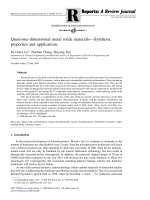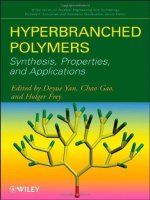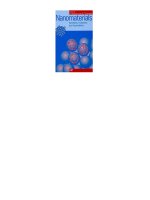- Trang chủ >>
- Khoa Học Tự Nhiên >>
- Vật lý
nanomaterials. synthesis, properties and applications, 1996, p.687
Bạn đang xem bản rút gọn của tài liệu. Xem và tải ngay bản đầy đủ của tài liệu tại đây (13.01 MB, 687 trang )
P
á
g
ina 1 de 1Document
04/04/2004htt
p
://www.netlibrar
y
.com/nlreader/nlreader.dll?bookid=27445&filename=Cover.html
Page iii
Nanomaterials
S
y
nthesis, Pro
p
erties and A
pp
lications
Edited by
A S Edelstein
Naval Research Laboratory
Washin
g
ton, DC
an
d
R C Cammarat
a
Department of Materials Science and Engineering
Johns Hopkins University
Baltimore, MD
P
á
g
ina 1 de 1Document
04/04/2004htt
p
://www.netlibrar
y
.com/nlreader/nlreader.dll?bookid=27445&filename=Pa
g
e
_
iii.html
Page iv
Copyright © 1996 by IOP Publishing Ltd and individual contributors. All rights reserved. No part of
this publication may be reproduced, stored in a retrieval system or transmitted in any form or by any
means, electronic, mechanical, photocopying, recording or otherwise, without the written permission of
the publisher, except as stated below. Single photocopies of single articles may be made for private
study or research. Illustrations and short extracts from the text of individual contributions may be
copied provided that the source is acknowledged, the permission of the authors is obtained and IOP
Publishing Ltd is notified. Multiple copying is permitted in accordance with the terms of the licences
issued by the Copyright Licensing Agency under the terms of its agreement with the Committee of
Vice-Chancellors and Princi
p
als.
B
ritish Librar
y
Catalo
g
uin
g
in Publication Data
A catalo
g
ue record for this book is available from the British Librar
y
.
ISBN 0 7503 0358 1 (hbk)
ISBN 0 7503 0578 9
(p
bk
)
L
ibrar
y
o
f
Con
g
ress Catalo
g
in
g
-in-Publication Data are available
First published 1996
Pa
p
erback edition 1998
Published by Institute of Physics Publishing, wholly owned by The Institute of Physics, London
Institute of Physics Publishing, Dirac House, Temple Back, Bristol BS1 6BE, UK
US Office: Institute of Physics Publishing, The Public Ledger Building, Suite 1035, 150 South
Inde
p
endence Mall West, Philadel
p
hia, PA 19106, USA
Printed in the UK b
y
J W Arrowsmith Ltd, Bristol
P
á
g
ina 1 de 1Document
04/04/2004htt
p
://www.netlibrar
y
.com/nlreader/nlreader.dll?bookid=27445&filename=Pa
g
e
_
iv.html
Page v
CONTENTS
Preface
xv
Authors' Addresses
xvii
Acknowled
g
ments
xxi
Part 1
Introduction
1
1
Introduction
3
Part 2
S
y
nthesis
11
2
Formation of Clusters and Nanoparticles from a Supersaturated Vapor and
Selected Pro
p
erties
13
2.1 Introduction 13
2.2 Clusters 14
2.2.1 Classical Nucleation Theor
y
for Cluster Formation 14
2.2.2 Techni
q
ues for Cluster Formation 16
2.2.3 Cluster Assembled Materials 24
2.2.4 Ph
y
sical and Chemical Pro
p
erties of Clusters 26
2.3 Nanoparticles Produced by Sputtering and Thermal Evaporation and
Laser Methods
35
2.3.1 Back
g
roun
d
35
2.3.2 Achievin
g
Su
p
ersaturation 38
2.3.3 Particle Nucleation and Growth 40
P
á
g
ina 1 de 2Document
04/04/2004htt
p
://www.netlibrar
y
.com/nlreader/nlreader.dll?bookid=27445&filename=Pa
g
e
_
v.html
2.3.4 Coalescence, Coa
g
ulation and Size Distributions 41
2.3.5 Particle Trans
p
ort 43
2.3.6 Particle Collection 45
2.3.7 Cr
y
stal Structure and Cr
y
stal Habit 45
3
Particle S
y
nthesis b
y
Chemical Routes
55
3.1 Introduction 55
P
á
g
ina 2 de 2Document
04/04/2004htt
p
://www.netlibrar
y
.com/nlreader/nlreader.dll?bookid=27445&filename=Pa
g
e
_
v.html
Page vi
3.2 Nucleation and Growth from Solutions 57
3.3 Stabilization of Fine Particles a
g
ainst A
gg
lomeration 57
3.4 Materials 59
3.4.1 Metals and Intermetallics 59
3.4.2 Ceramics 62
3.4.3 Com
p
osites 63
3.4.4 Nano
p
articles via Or
g
anized Membranes 65
3.4.5 Clusters 67
3.5 Conclusions 68
4
S
y
nthesis of Semiconductor Nanoclusters
73
4.1 Characterization Methods and Potential Pitfalls in the S
y
nthesis 74
4.2 Colloids/Micelles/Vesicles 76
4.3 Pol
y
mers 78
4.4 Glasses 79
4.5 Cr
y
stalline and Zeolite Hosts 80
4.6 Towards Sin
g
le-size Clusters 82
4.6.1 Controlled Cluster Fusion in Solution 83
4.6.2 Controlled Thermol
y
sis in the Solid State 84
5
Formation of Nanostructures b
y
Mechanical Attrition
89
5.1 Introduction and Back
g
roun
d
89
P
á
g
ina 1 de 2Document
04/04/2004htt
p
://www.netlibrar
y
.com/nlreader/nlreader.dll?bookid=27445&filename=Pa
g
e
_
vi.html
5.2 Hi
g
h-ener
gy
Ball Millin
g
and Mechanical Attrition 90
5.3 Phenomenolo
gy
of Nanostructure Formation 92
5.3.1 Elements and Intermetallics 92
5.3.2 None
q
uilibrium Solid Solutions 95
5.3.3 Nanocom
p
osites b
y
Mechano-chemistr
y
97
5.4 Mechanism of Grain-size Reduction 99
5.5 Pro
p
ert
y
–microstructure Relationshi
p
s 103
5.6 Related To
p
ics 108
Part 3
Artificiall
y
Multila
y
ered Materials
111
6
Artificiall
y
Multila
y
ered Materials
113
6.1 Introduction 113
6.2 Structure and Characterization 114
6.2.1 Microstructure 114
6.2.2 Dislocation Filters 117
6.2.3 Characterization 117
6.3 Processin
g
120
6.3.1 Thin-film De
p
osition Methods 120
P
á
g
ina 2 de 2Document
04/04/2004htt
p
://www.netlibrar
y
.com/nlreader/nlreader.dll?bookid=27445&filename=Pa
g
e
_
vi.html
Page vii
6.3.2 Mechanical Processin
g
Methods 126
6.4 Thermod
y
namics and Kinetics 126
6.4.1 Thermod
y
namics 126
6.4.2 Kinetics 127
6.5 Electrical and O
p
tical Pro
p
erties 128
6.5.1 Semiconductor Su
p
erlattices 128
6.5.2 Microelectronics A
pp
lications 130
6.5.3 O
p
toelectronics A
pp
lications 131
6.5.4 Electronic Trans
p
ort in Metallic Multila
y
ers 132
6.5.5 Bra
gg
Reflectors 133
6.6 Su
p
erconductin
g
Pro
p
erties 134
6.6.1 Low-tem
p
erature Su
p
erconductors 134
6.6.2 Hi
g
h-tem
p
erature Su
p
erconductors 134
6.7 Ma
g
netic Pro
p
erties 135
6.7.1 Ma
g
netic Su
p
erlattices 135
6.7.2 Giant Ma
g
netoresistance 136
6.8 Mechanical Pro
p
erties 137
6.8.1 Elastic Pro
p
erties 137
6.8.2 Dam
p
in
g
Ca
p
acit
y
138
6.8.3 Plastic Pro
p
erties 138
6.8.4 Wear and Friction 140
P
á
g
ina 1 de 2Document
04/04/2004htt
p
://www.netlibrar
y
.com/nlreader/nlreader.dll?bookid=27445&filename=Pa
g
e
_
vii.html
6.8.5 Fracture 140
Part 4
Processin
g
of Nanomaterials
145
7
Processin
g
of Nanostructured Sol–
g
el Materials
147
7.1 Introduction 147
7.2 S
y
nthesis of Oxides b
y
the Sol–
g
el Process 149
7.2.1 Alkoxide Solution Routes 149
7.2.2 Colloidal Sols and Sus
p
ensions 151
7.2.3 Sin
g
le-com
p
onent Oxides 152
7.2.4 Multicom
p
onent Oxides 152
7.3 Powde
r
-free Processin
g
of Gel Sha
p
es 152
7.3.1 Thin Films 153
7.3.2 Fibers, Sheets and Thick La
y
ers 154
7.3.3 Micro
p
orous Monoliths 155
7.4 Unconsolidated Gels: A
g
in
g
and S
y
neresis 155
7.5 Consolidated Gels: Sinterin
g
156
7.6 Matrices for Access to the Nanostructure 157
7.6.1
I
n situ
com
p
osites 159
7.6.2 Volatile Host Metho
d
159
7.6.3 Infiltrated Com
p
osites 161
P
á
g
ina 2 de 2Document
04/04/2004htt
p
://www.netlibrar
y
.com/nlreader/nlreader.dll?bookid=27445&filename=Pa
g
e
_
vii.html
Page viii
7.7 Pros
p
ects for the Sol–
g
el Processin
g
of Nanostructured Materials 161
8
Consolidation of Nanocr
y
stalline Materials b
y
Com
p
action and Sinterin
g
165
8.1 Introduction 165
8.2 Dr
y
Com
p
action of Nanocr
y
stalline Particles 166
8.3 Wet Com
p
action of Nanocr
y
stalline Particles 169
8.4 Ideal Densification durin
g
Pressureless Sinterin
g
170
8.5 Non-ideal Densification durin
g
Pressureless Sinterin
g
177
8.5.1 A
gg
lomeration Effects 177
8.5.2 Inhomo
g
eneous Sinterin
g
/Differential Densification 179
8.6 Grain Growth durin
g
Pressureless Sinterin
g
182
8.7 Grain Boundar
y
Pinnin
g
b
y
Pores durin
g
Pressureless Sinterin
g
186
8.8 Minimizing Grain Growth and Maximizing Densification during
Pressureless Sinterin
g
187
8.9 Pressure-assisted Sinterin
g
and Sinter For
g
in
g
189
8.10 Summar
y
194
Part 5
Characterization of Nanostructured Materials
199
9
N
anostructures of Metals and Ceramics
201
9.1 Introduction 201
9.2 Structures of Nano
p
hase Materials 203
P
á
g
ina 1 de 2Document
04/04/2004htt
p
://www.netlibrar
y
.com/nlreader/nlreader.dll?bookid=27445&filename=Pa
g
e
_
viii.html
9.2.1 Grains 203
9.2.2 Atomic Defects and Dislocations 204
9.2.3 Pores 207
9.2.4 Grain Boundaries 210
9.2.5 Stabilit
y
212
9.2.6 Strains 214
9.3 Conclusions 215
10
Characterization b
y
Scatterin
g
Techni
q
ues and EXAFS
219
10.1 Introduction 219
10.2 Real-space Information from Experimental Reciprocal-space Data:
Atomic Distribution Function
222
10.2.1 Real-s
p
ace-reci
p
rocal-s
p
ace Relations 222
10.2.2 Atomic Distribution and Interference Functions for Arrays of
N
anometer Particles
223
P
á
g
ina 2 de 2Document
04/04/2004htt
p
://www.netlibrar
y
.com/nlreader/nlreader.dll?bookid=27445&filename=Pa
g
e
_
viii.html
Page ix
10.2.3 Comparison of a Non-reconstructed Nanocrystalline Solid to
Isolated Particles
225
10.2.4 Nanocrystalline Solid with a Disordered Grain Boundary
Com
p
onent
226
10.2.5 Particles with a Distribution of Sizes 227
10.3 Characterizin
g
the Cr
y
stal Lattice 230
10.3.1 Cr
y
stallo
g
ra
p
hic Phase and Lattice Constant 230
10.3.2 Grain-size Distribution 233
10.3.3 Grain Growth and Control of Grain Size 238
10.3.4 Lattice Strain 241
10.3.5 Stackin
g
Faults and Twin Boundaries 245
10.3.6 Short- and Medium-ran
g
e Correlated Dis
p
lacements 246
10.4 Characterizin
g
the Grain Boundaries 250
10.4.1 Relation Between Grain Boundary Short-range Order and
Grain Size
250
10.4.2 Grain Boundary Short-range Order in Nanocrystalline
Solids
251
10.4.3 Grain Boundar
y
Short-ran
g
e Order from EXAFS Studies 254
10.5 Distribution of Free Volume from Small-an
g
le Scatterin
g
257
10.6 Nanostructured Amor
p
hous Solids 264
10.7 Ma
g
netic Structure 266
10.8 D
y
namics from Inelastic Neutron Scatterin
g
269
10.9 Summar
y
270
P
á
g
ina 1 de 2Document
04/04/2004htt
p
://www.netlibrar
y
.com/nlreader/nlreader.dll?bookid=27445&filename=Pa
g
e
_
ix.html
11
Interfacial Free Volumes and Atomic Diffusion in Nanostructured Solids
277
11.1 Introduction 277
11.2 Pre
p
aration and Characterization of Nanocr
y
stalline Materials 278
11.3 Structural Free Volumes in Nanophase Materials as Probed by
Positrons
279
11.3.1 The Techni
q
ue of Positron Lifetime S
p
ectrosco
py
279
11.3.2 Nanocr
y
stalline Metals 280
11.3.3 Nanocr
y
stalline Allo
y
s 288
11.3.4 Nanocr
y
stalline Silicon 290
11.3.5 Nanocr
y
stalline Ceramics 291
11.4 Diffusion 294
11.5 Helium Desor
p
tion after Im
p
lantation 295
P
á
g
ina 2 de 2Document
04/04/2004htt
p
://www.netlibrar
y
.com/nlreader/nlreader.dll?bookid=27445&filename=Pa
g
e
_
ix.html
Page x
Part 6
Pro
p
erties of Nanostructured Materials
303
12
Chemical Pro
p
erties
305
12.1 Introduction 305
12.2 Exam
p
les of Nanostructures in Chemistr
y
306
12.2.1 Colloids 306
12.2.2 Su
pp
orted Nanoscale Catal
y
sts 307
12.2.3 Nucleation Phenomena 308
12.3 The Effect of Nanoscale Materials on Chemical Reactivit
y
309
12.3.1 Chemical Reactivity: Metal Nanocrystallites Supported on
Oxides
309
12.3.2 Electrochemical Reactivit
y
310
12.3.3 Effect of Nanostructures on Mass Trans
p
ort 314
12.4 The Effect of Chemistr
y
on Nanostructures 316
12.5 Conclusions 318
13
Mechanical Pro
p
erties
323
13.1 Low-tem
p
erature Pro
p
erties: Yield Stren
g
th 323
13.1.1 Nanocr
y
stalline Metals and Allo
y
s 323
13.1.2 Nanocr
y
stalline Ceramics 333
13.2 Hi
g
h-tem
p
erature Pro
p
erties: Su
p
er
p
lasticit
y
333
P
á
g
ina 1 de 3Document
04/04/2004htt
p
://www.netlibrar
y
.com/nlreader/nlreader.dll?bookid=27445&filename=Pa
g
e
_
x.html
13.2.1 Back
g
round of Su
p
er
p
lasticit
y
334
13.2.2 Surve
y
of Ex
p
erimental Results 337
13.2.3 Sinter For
g
in
g
341
13.3 Future Directions 343
14
Ma
g
netic and Electron Trans
p
ort Pro
p
erties of Granular Films
347
14.1 Introduction 347
14.2 Microstructure 348
14.3 Ma
g
netic Pro
p
erties 352
14.3.1 Overview 353
14.3.2 Su
p
er
p
arama
g
netic Pro
p
erties 356
14.3.3 Ferroma
g
netic Pro
p
erties 359
14.4 Electrical Trans
p
ort Pro
p
erties 360
14.4.1 Overview 361
14.4.2 Metallic Re
g
ime 363
14.4.3 Insulatin
g
Re
g
ime 365
14.5 Giant Ma
g
netoresistance 367
14.6 Summar
y
371
15
Ma
g
netic and Structural Pro
p
erties of Nano
p
articles
375
15.1 Introduction 375
15.2 Smoke Particles 377
P
á
g
ina 2 de 3Document
04/04/2004htt
p
://www.netlibrar
y
.com/nlreader/nlreader.dll?bookid=27445&filename=Pa
g
e
_
x.html
15.2.1 Particle Size Variation and Distribution 377
P
á
g
ina 3 de 3Document
04/04/2004htt
p
://www.netlibrar
y
.com/nlreader/nlreader.dll?bookid=27445&filename=Pa
g
e
_
x.html
Page xi
15.2.2 Cr
y
stal Structures and Particle Mor
p
holo
gy
379
15.2.3 Effects of Particle Size and Surface Chemistry on Magnetic
Pro
p
erties
381
15.2.4 'Core–Shell' Particle Model 385
15.3 Solvated Metal Atom Dis
p
ersion Techni
q
ue
(
SMAD
)
387
15.3.1 The S
y
nthetic Metho
d
387
15.3.2 Ma
g
netic Pro
p
erties 388
15.4 Aerosol S
p
ra
y
P
y
rol
y
sis 389
15.4.1 The S
y
nthetic Metho
d
389
15.4.2 BaFe
12
O
19
390
15.4.3 Gd
3
Fe
5
O
12
390
15.4.4 MnFe
2
O
4
390
15.5 Summar
y
391
16
Optical Characterization and Applications of Semiconductor Quantum
Dots
395
16.1 Introduction 395
16.2 O
p
tical Characterization 396
16.2.1 Linear O
p
tical Pro
p
erties 396
16.2.2 Electro-o
p
tical Pro
p
erties 402
16.2.3 Nonlinear O
p
tical Pro
p
erties 403
16.2.4 Two-
p
hoton Absor
p
tion and Confinement-induced Mixin
g
of
408
P
á
g
ina 1 de 2Document
04/04/2004htt
p
://www.netlibrar
y
.com/nlreader/nlreader.dll?bookid=27445&filename=Pa
g
e
_
xi.html
Valence Bands
16.3 Theor
y
of Nonlinear O
p
tical Res
p
onse 412
16.3.1 Nonlinear O
p
tical Res
p
onse 412
16.3.2 Excitonic Su
p
erradiance from Microcr
y
stallites 415
16.3.3 Su
p
erradiance from Interactin
g
Frenkel Excitons 416
16.3.4 Enhancement of O
p
tical Nonlinearit
y
417
16.4 A
pp
lications 419
16.4.1 Quantum-dot Lasers 419
16.4.2 All-o
p
tical Switchin
g
Usin
g
Quantum Dots 426
16.4.3 Quantum Dots for O
p
tical Data Stora
g
e 431
Part 7
S
p
ecial Nanomaterials
437
17
Porous Si Nanostructures
439
17.1 Introduction 439
17.2 Porous Silicon Formation 440
17.3 Surface Chemistr
y
442
17.4 Relationshi
p
Between Structure, Surfaces and O
p
tical Pro
p
erties 442
17.4.1 Quantum Confinement Mechanism 443
P
á
g
ina 2 de 2Document
04/04/2004htt
p
://www.netlibrar
y
.com/nlreader/nlreader.dll?bookid=27445&filename=Pa
g
e
_
xi.html
Page xii
17.4.2 Difficulties with Quantum Confinement 444
17.4.3 Photoluminescence from H
y
drides/Pol
y
silanes 449
17.4.4 Silicon Bandtail State Model 450
17.4.5 Siloxene Luminescence Mechanism 450
17.4.6 Oxide-related Interfacial States 451
17.5 Conclusion 454
18
Biolo
g
ical Nanomaterials
459
18.1 Introduction 459
18.2 Ferritins and Related Proteins 460
18.2.1 Back
g
roun
d
460
18.2.2 Ferritin as a Su
p
er
p
arama
g
netic Model S
y
stem 461
18.2.3 Different Native Forms of Ferritin and Hemosiderin 464
18.2.4 Ma
g
netoferritin 466
18.2.5 Other Ferritin Derivatives and Future Possibilities 468
18.3 Ma
g
netotactic Bacteria 468
18.3.1 Ma
g
netic Direction Findin
g
468
18.3.2 The Ma
g
netosomes 469
18.4 Molluscan Teeth 471
18.4.1 Introduction 471
18.4.2 Biomineralization of Structural Com
p
onents 472
P
á
g
ina 1 de 3Document
04/04/2004htt
p
://www.netlibrar
y
.com/nlreader/nlreader.dll?bookid=27445&filename=Pa
g
e
_
xii.html
18.5 Conclusions 475
19
S
y
nthesis, Structure, and Pro
p
erties of Fullerenes
477
19.1 Introduction 477
19.2 S
y
nthesis 478
19.2.1 Synthesis of C
60
and C
70
479
19.2.2 S
y
nthesis of Giant Fullerenes 480
19.3 Molecular and Cr
y
stalline Structure 482
19.3.1 The C
60
Molecule—buckminsterfullerene 482
19.3.2 The Soli
d
—fullerite 483
19.3.3 Lar
g
er Fullerenes 485
19.3.4 Tubes and Onions 486
19.4 Pro
p
erties 486
19.4.1 Properties of the C
60
Molecule 487
19.4.2 Pro
p
erties of the Soli
d
488
19.4.3 Clusters of Clusters 489
19.4.4 Various Forms of Fullerene Materials 489
19.4.5 A
pp
lications of the Fullerenes 490
Part 8
Nanofabrication and Nanoelectronics
495
20
N
anofabrication and Nanoelectronics
497
P
á
g
ina 2 de 3Document
04/04/2004htt
p
://www.netlibrar
y
.com/nlreader/nlreader.dll?bookid=27445&filename=Pa
g
e
_
xii.html
20.1 Introduction 497
P
á
g
ina 3 de 3Document
04/04/2004htt
p
://www.netlibrar
y
.com/nlreader/nlreader.dll?bookid=27445&filename=Pa
g
e
_
xii.html
Page xiii
20.2 Nanofabrication 501
20.2.1 Resists 501
20.2.2 Litho
g
ra
p
h
y
503
20.2.3 Pattern Transfe
r
510
20.3 Nanoelectronics 515
20.3.1 Nanodevices 517
20.3.2 Nanotransistor Desi
g
ns 523
20.3.3 Nanoelectro-o
p
tics 532
20.3.4 Ph
y
sical Modelin
g
and Device Simulation 532
20.4 Summar
y
533
Part 9
Assessment of Technolo
g
ical Im
p
act
541
21
N
ote from the Editors
543
22
General Overview
545
22.1 Mechanical Pro
p
erties 545
22.1.1 Ph
y
sical Methods 546
22.1.2 Chemical Methods 546
22.1.3 Com
p
osites 547
22.1.4 Material Characterization 547
22.1.5 Pro
p
erties and A
pp
lications 547
P
á
g
ina 1 de 3Document
04/04/2004htt
p
://www.netlibrar
y
.com/nlreader/nlreader.dll?bookid=27445&filename=Pa
g
e
_
xiii.html
22.2 Electronic, Ma
g
netic, and O
p
tical Pro
p
erties 548
22.2.1 Semiconductors 548
22.2.2 Characterization 550
22.2.3 Pro
p
erties and A
pp
lications 551
22.3 Conclusion 552
23
Im
p
act on Chemistr
y
and Related Technolo
gy
555
23.1 Introduction 555
23.2 Im
p
act on Chemistr
y
and Related Technolo
gy
557
23.2.1 Anal
y
tical Chemistr
y
: Chemical Sensors 557
23.2.2 Litho
g
ra
p
h
y
557
23.2.3 Chemical Vapor/Electrochemical Deposition of
Films/Coatin
g
s: Nucleation/Growth
558
23.2.4 Maintainability and Reliability:
Corrosion/Adhesion/Tribolo
gy
559
23.2.5 Macromolecules/Biochemistr
y
559
23.2.6 Clusters 560
23.3 Conclusion 561
24
N
anostructures in Electronics
565
25
Memories and Electronic Devices
567
P
á
g
ina 2 de 3Document
04/04/2004htt
p
://www.netlibrar
y
.com/nlreader/nlreader.dll?bookid=27445&filename=Pa
g
e
_
xiii.html
Page xiv
26
N
anostructured Materials for Ma
g
netic Recordin
g
569
26.1 Introduction 569
26.2 Back
g
roun
d
569
26.3 Media 570
26.3.1 Film Media 571
26.3.2 General Media Issues 571
26.4 Recordin
g
Heads 572
26.5 Summar
y
572
27
Commercialization Opportunities for Nanophase Ceramics: A Small
Com
p
an
y
Pers
p
ective
573
27.1 Introduction 573
27.2 S
y
nthesis 573
27.3 Bulk Consolidated Structures 575
27.4 Porous Platforms 576
27.5 Dis
p
ersions 578
27.6 Conclusions 580
Sub
j
ect Index
583
Materials Index
593
P
á
g
ina 1 de 1Document
04/04/2004htt
p
://www.netlibrar
y
.com/nlreader/nlreader.dll?bookid=27445&filename=Pa
g
e
_
xiv.html
Page xv
PREFACE
N
anomaterials has recently become one of the most active research fields in the areas of solid state
p
hysics, chemistry, and engineering. Evidence of this interest is provided by the large number of recent
conferences and research papers devoted to the subject. There are several reasons for this. One is the
need to fabricate new materials on an ever finer scale to continue decreasing the cost and increasing the
speed of information transmission and storage. Another is that nanomaterials display novel and often
enhanced properties compared to traditional materials, which opens up possibilities for new
technolo
g
ical a
pp
lications.
This book grew out of the editors' realization, after attending several conferences on nanomaterials, of
the breadth of this field and the lack of a text that covered its diverse subjects. Furthermore, workers in
one area were largely unaware of work in other areas. This book is intended to satisfy this need for a
broad coverage that will provide an introduction, background, and references to nearly all areas of
nanomaterials research. It includes an extensive list of references at the end of nearly every chapter. As
an illustration of the breadth of this subject, it is noted that even after the preparation of the book was at
a fairly late stage, the editors found that important subjects had been overlooked and decided to add
several new cha
p
ters.
The editors wish to thank the authors for their efforts in writing their chapters so that they would be
accessible to a general audience, and Kathryn Cantley, Steve Clewer, Don Emerson and Pamela
Whichard at Institute of Ph
y
sics Publishin
g
for their invaluable assistance.
The editors would like to acknowledge the important contributions made by many researchers in the
field of nanomaterials whose work could not be cited because of lack of s
p
ace.
A S EDELSTEIN
R C CAMMARATA
FEBRUARY 1996
P
á
g
ina 1 de 1Document
04/04/2004htt
p
://www.netlibrar
y
.com/nlreader/nlreader.dll?bookid=27445&filename=Pa
g
e
_
xv.html









